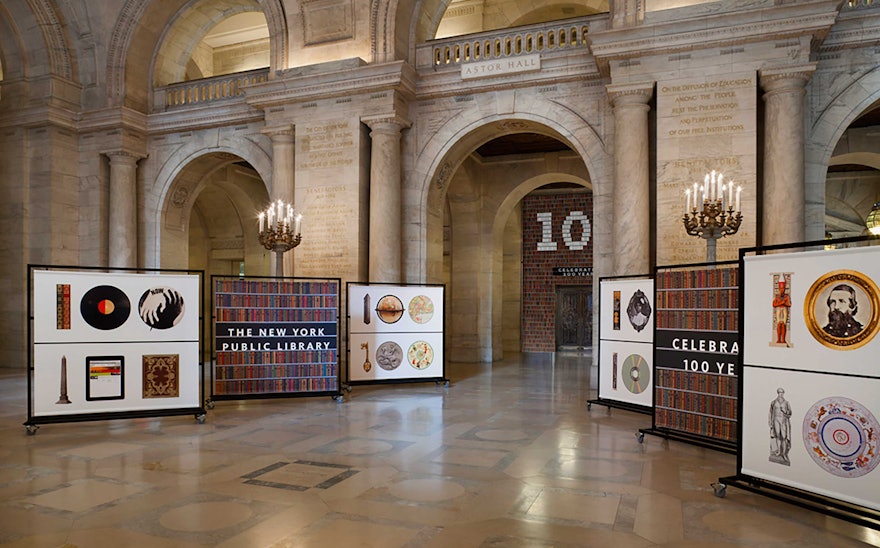On May 23, 2011, the New York Public Library celebrated the 100th anniversary of its landmark Stephen A. Schwarzman Building at Fifth Avenue and 42nd Street. Pentagram has designed Celebrating 100 Years, the library’s centennial exhibition, a presentation of 250 astonishing artifacts that highlight the collections and history of this remarkable institution.
With over 60 million artifacts in its holdings, the New York Public Library is one of the world’s great libraries, but it is different from its peers—places like the British Library and the Library of Congress—in that it is not a national institution, but rather a municipal library conceived as a repository of knowledge for the citizens of New York. (The library is nicknamed the “People’s Palace,” and it is the only institution in the world that always makes its collections accessible to the public.) The library has its roots in the Astor and Lenox libraries, which were combined in 1895 with the Tilden Trust and found a new home in the magnificent Beaux-Arts building now known as the Stephen A. Schwarzman Building, built in 1911 and recognized for its beloved marble lions, Patience and Fortitude.
The designers worked closely with Thomas Mellins, the exhibition curator, and Paul LeClerc, the Library's President, on the development of the show. The exhibition has been mounted in the D. Samuel and Jeane H. Gottesman Exhibition Hall, one of the library’s most beautiful rooms and its main exhibition space. The displayed objects—many rarely seen—extend far beyond books to show the breadth and depth of the library’s encyclopedic collections, which span thousands of years and range from historic objects and artworks to symbols of our collective memory.
To showcase the diversity of the collections, the exhibition has been organized into four sections: Observation, artifacts that document the natural world; Contemplation, items that demonstrate a search for meaning through reflection or spirituality; Creativity, items from the library’s collections on the arts; and Society, materials documenting political and social history. These sections are announced with illuminated archways that spotlight the architecture of Gottesman Hall, showcasing it as another of the library’s great treasures.
The sections flow into each other, allowing visitors to explore and make their own connections. Among the amazing artifacts on display are: Thomas Jefferson’s handwritten version of the Declaration of Independence; George Washington’s final draft of his farewell address, Charles Dickens’ letter opener, made from the paw of his beloved cat, Bob; Beethoven’s handwritten score for the Archduke Trio; a first edition copy of Mary Shelley’s Frankenstein; artists books by Henri Matisse and Joan Miro; Malcolm X’s journal, briefcase and copy of the Qur’an; Virginia Woolf’s walking stick, found in the river where she drowned; Charlotte Bronte’s traveling writing desk; Jack Kerouac’s notebooks and personal effects; a signed copy of Hitler’s Mein Kampf; iconic political posters from the civil rights movement; and the first whole Earth photo from Apollo 8.
Several large display cases specifically juxtapose objects that demonstrate the range of the collection, comparing, for instance, a letter from Christopher Columbus with an image from the Apollo 12 mission; cuneiforms with The New York Times website; and a drawing of a Palladian villa with an image of a New York apartment building.
The room’s central space displays several prized artifacts that document changes in the way information has been recorded and shared over time, including Sumerian cuneiform tablets from 2300 BCE; a Gutenberg Bible from 1455; a cyanotype of British algae from 1843-53, one of the first photographic images; the first Xerox, from 1938; and in a large projection, selections from the library’s Digital Gallery. (The NYPL started its Digital Libraries Collection in 1998.)
The projection features more than 800 images, arranged in thematic groupings that include images of New York City, maps, advertisements, bookjackets, faces and Ancient Egypt and its influences, a tribute to the modern library’s roots in Alexandria. For the presentation, the designers created a fluid animation that places the images in a grid-like formation inspired by library shelves. The images alternate with fun facts about the library and its collections.
In the adjacent Sue and Edgar Wachenheim III Gallery, which once served as the director’s office, the exhibition looks at the library’s origins, history and cultural impact. A glass bookcase displays 100 books researched or written at the library, emphasizing its importance as a research institution. The designers created an iPad app that allows visitors to explore these books and browse hundreds of thousands of images in the library’s Digital Gallery. Large media displays portray the vast collections of the library and present historical images and facts, and artifacts tell the story of the development of the library, including architectural plans of the building, photographs of its construction and a mapping video about the area where the library sits, originally part of the Croton Reservoir.
The designers also created a bold graphic identity for the exhibition, which forms the number “100” from objects in the library’s collection. The graphics are featured on banners on the library’s iconic façade and displays in the lobby.

